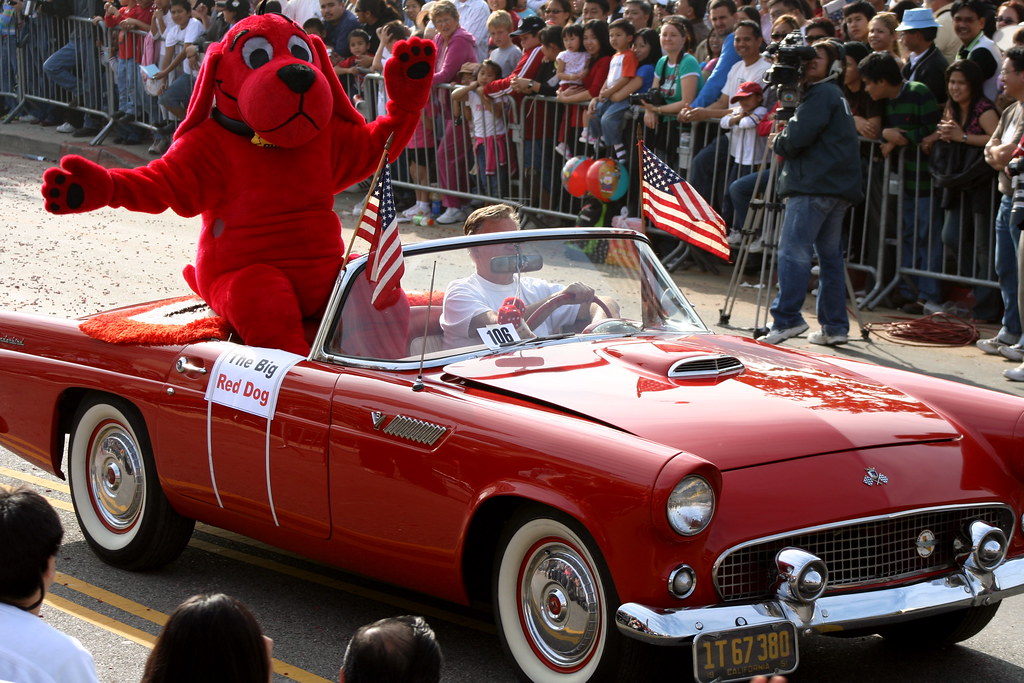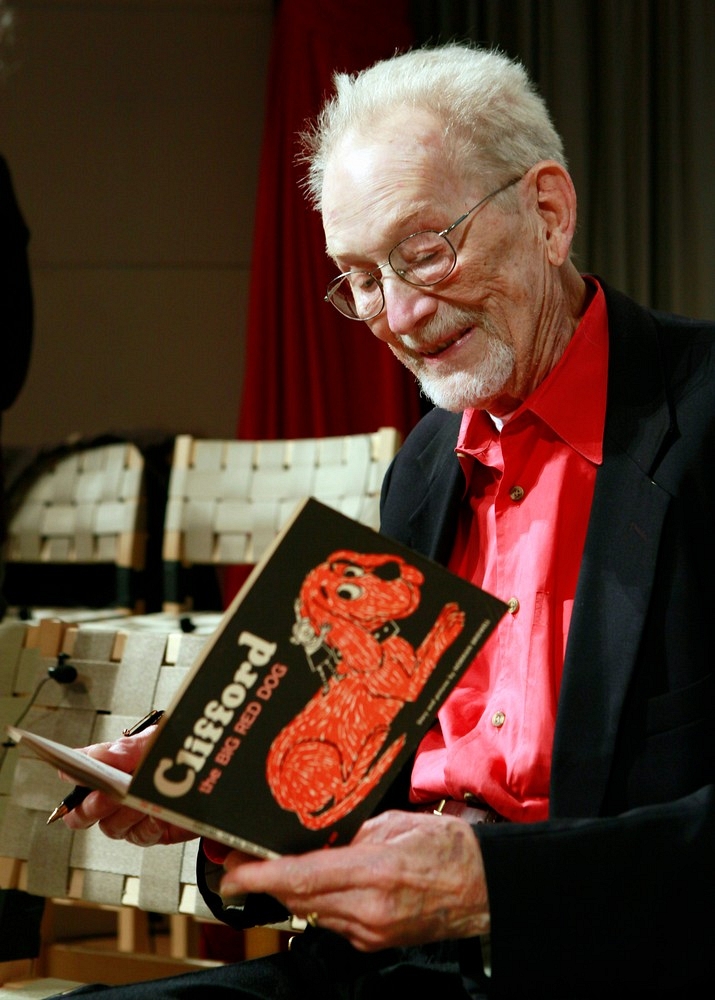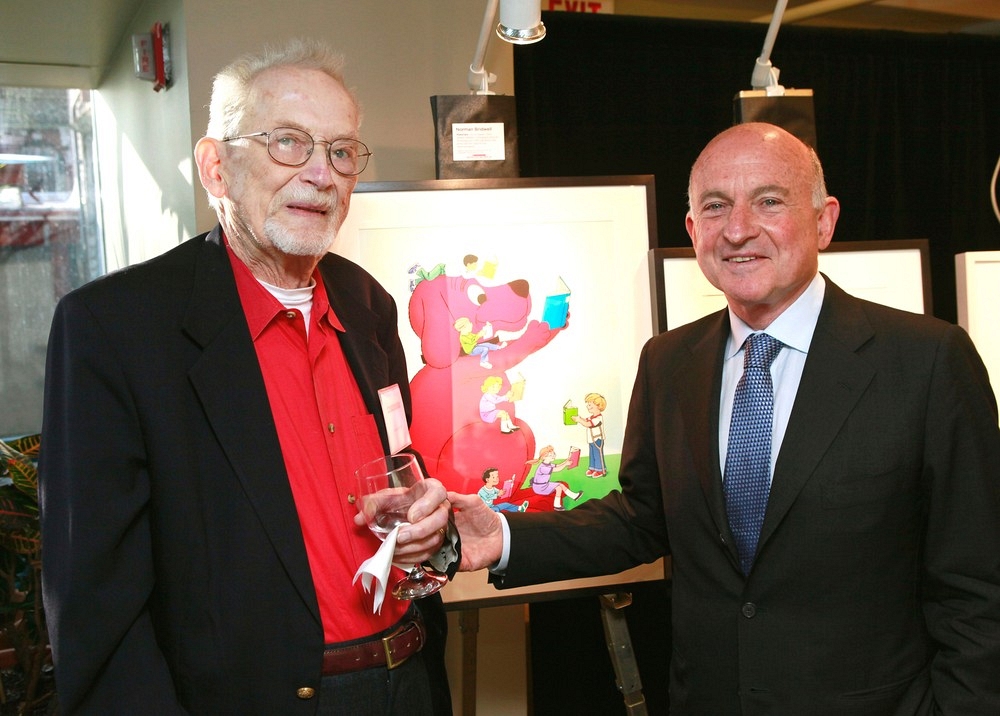
The world of children’s literature recently mourned the passing of Norman Ray Bridwell, the American author and cartoonist celebrated globally for creating the endearing ‘Clifford the Big Red Dog’ book series. Bridwell, whose gentle spirit and keen sense of humor brought to life one of childhood’s most cherished characters, died at Martha’s Vineyard Hospital on December 12, 2014, at the age of 86, leaving behind a profound legacy of stories that emphasized kindness, compassion, and the power of unconditional love.
Bridwell’s work transcended simple storytelling, instilling vital values in generations of young readers and their parents. Through Clifford, a dog whose immense size was matched only by his even greater heart, Bridwell crafted narratives that resonated deeply, portraying a character who, despite his clumsiness and mistakes, was always met with understanding and forgiveness from his devoted owner, Emily Elizabeth. This central theme of unwavering affection served as a comforting touchstone for millions, demonstrating the profound impact a gentle, well-meaning soul can have on the world.
His journey from a self-doubting young artist to a literary giant is a testament to perseverance and the unexpected paths creativity can take. This retrospective examines the pivotal moments in Norman Bridwell’s life and career, from his formative years and early struggles to the serendipitous creation and initial challenges of bringing Clifford to the world, revealing the intricate tapestry of experiences that shaped a beloved storyteller.

1. **Early Life and Artistic Aspirations**Born on February 15, 1928, in Kokomo, Indiana, Norman Ray Bridwell entered a world far removed from the bustling publishing houses of New York. His early life was characterized by a quiet passion for drawing, an activity he pursued frequently despite harboring significant self-doubt about his artistic capabilities. Growing up, Bridwell often felt he was not particularly gifted, an sentiment that persisted even during his academic years.
His high school experience at Kokomo High School in the 1940s further cemented this self-perception. Bridwell often believed that there were always students more talented than him in both his art and writing classes, a common struggle for many aspiring creatives who measure their own nascent talents against those they perceive as superior. Yet, this underlying current of self-criticism did not deter his ambition.
Upon graduating from high school in 1945, Bridwell chose to pursue his artistic inclinations more formally, embarking on a path that would eventually lead him to the heights of children’s literature. He enrolled at the John Herron School of Art at Indiana University – Purdue University Indianapolis, seeking to hone his craft and gain a more structured foundation in art. His education continued at Cooper Union in New York City, a move that placed him at the heart of the nation’s artistic and publishing world, even if success remained elusive for a time.
These early experiences, marked by both a deep-seated love for drawing and a pervasive sense of inadequacy, laid the groundwork for a career that would ultimately defy his youthful apprehensions. They speak to the quiet determination that often underlies great creative achievements, proving that passion, even when accompanied by self-doubt, can forge extraordinary paths.
Product on Amazon: The Fancy Schmancy Lifeguard: A Tale of Bravery (The Adventures of Two Travelling Poodles)
Binding: Kindle Edition Product Group: Digital Ebook Purchas
Price: 2.99 USD
Rating: 4.8 Total reviews: 149
Shopping on Amazon >>
Read more about: Unveiling the Enduring Luxury: Janet Jackson’s Illustrious Career and Cultural Impact

2. **Struggles as a Freelance Commercial Artist**Following his formal art education, Norman Bridwell embarked on his professional career as a freelance commercial artist in the vibrant, competitive landscape of New York City. This period, however, was far from glamorous, characterized instead by significant financial hardship. Bridwell found himself in a constant struggle to meet the basic needs of his growing family, which included his wife, Norma Ellen Howard, and their young daughter.
The pressures of supporting his loved ones fueled a desire to find more stable or lucrative work. By 1962, seeking to supplement his meager income, Bridwell compiled a portfolio of his illustrations with the ambition of securing a job as a children’s book illustrator. This endeavor, while hopeful, was met with a series of disheartening rejections, a common experience for many artists attempting to break into the tightly competitive publishing industry.
He presented his work to approximately fifteen different publishing houses, each visit ending with a similar outcome: rejection. This period of repeated setbacks could have easily discouraged a less resilient individual, reinforcing his earlier self-doubts about his artistic abilities. The consistent refusal from established publishers underscored the immense challenges he faced in transforming his artistic talent into a sustainable career.
These years of struggle were instrumental in shaping Bridwell’s path, pushing him toward an unexpected pivot. The financial strain and the series of rejections highlighted the need for a new approach, ultimately setting the stage for a fortuitous encounter that would forever change his trajectory and the course of children’s literature, proving that sometimes, the greatest breakthroughs emerge from the most challenging circumstances.

3. **The Fateful Suggestion: From Drawing to Story**Amidst his numerous rejections and persistent efforts to secure illustration work, a pivotal moment occurred during a visit to Harper & Row. It was here that an editor, recognizing a nascent spark of potential despite the overall assessment of Bridwell’s portfolio, offered a piece of advice that would irrevocably alter his career path. This guidance was simple yet profound: while his art might not be strong enough to sell on its own, it possessed a quality that could be harnessed in a different way.
The editor’s keen eye singled out a specific drawing from Bridwell’s collection – an illustration depicting a young girl alongside a horse-sized bloodhound. This particular sketch, which might have otherwise been overlooked, caught the editor’s attention as having a unique narrative quality. The suggestion was clear: instead of merely illustrating, Bridwell should attempt to develop a story around this compelling visual concept.
This crucial piece of feedback served as a direct catalyst, shifting Bridwell’s focus from merely being an illustrator to becoming an author-illustrator. It was an invitation to weave narrative around his images, transforming a static drawing into a dynamic world of characters and events. The editor’s insight redirected Bridwell’s creative energy, providing a clear, actionable path forward where previous attempts had met dead ends.
Without this seemingly small suggestion, the beloved character that would soon capture the hearts of millions might never have materialized. This encounter underscored the often-unpredictable nature of creative breakthroughs, demonstrating how external perspectives can unlock an artist’s hidden potential and steer them toward their true calling, transforming a struggling artist’s fate with a single, insightful remark.

4. **The Genesis of Clifford the Big Red Dog**The editor’s suggestion sparked an immediate creative surge in Norman Bridwell, prompting him to focus on the drawing of the girl and the horse-sized bloodhound. Motivated by his young daughter, Emily Elizabeth, Bridwell found a compelling reason to develop a story around this particular illustration. He envisioned a tale that would resonate with children, drawing upon the inherent appeal of a special pet and the imaginative possibilities it presented.
A key decision in this creative process was to make the dog incredibly large, a defining characteristic that would set it apart and provide endless narrative opportunities. Bridwell made a conscious choice to portray the dog as “very big,” moving beyond a mere large animal to an exaggerated, lovable giant. This monumental scale became central to the character’s identity and the whimsical nature of the stories.
Furthermore, Bridwell refined the dog’s breed. Instead of retaining the specific characteristics of a bloodhound, he decided to transform it into a more generic, “all-around dog.” This change allowed Clifford to embody universal qualities of companionship and loyalty, making him more broadly relatable and less constrained by specific breed traits. The focus shifted to his personality and his bond with the girl, rather than his canine lineage.
With these foundational decisions in place, the story rapidly began to take shape. Within just a few days of receiving the editor’s transformative advice, Bridwell completed his initial manuscript and illustrations for what would become ‘Clifford the Big Red Dog.’ This swift creation underscored the power of a clear vision and the potent combination of a compelling visual and an inspired narrative concept, marking the birth of an iconic figure in children’s literature.
Product on Amazon: Clifford the Big Red Dog: Clifford’s Big Halloween
Brand: Lionsgate
Binding: DVD Product Group: DVD
Price: 4.98 USD
Rating: 4.2 Total reviews: 41
Genre: Kids & Family
Format: Animated, Closed-captioned, Color, Full Screen, Multiple Formats, NTSC
Contributor: Over, John
Language: English
Number Of Discs: 1
Shopping on Amazon >>

5. **The Naming of Clifford and Emily Elizabeth**The creative process behind the first ‘Clifford the Big Red Dog’ book extended beyond its narrative and illustrations to the thoughtful naming of its central characters. Norman Bridwell initially conceived a rather simple name for his enormous canine hero: “Tiny.” This choice, perhaps intended to be ironic given the dog’s colossal size, ultimately did not resonate with his wife, Norma Ellen Howard, who found it to be too uninspired and, as the context states, “too boring.”
It was Norma who provided the breakthrough, suggesting a name that would become synonymous with childhood joy: “Clifford.” This name held a special personal significance for her, as it belonged to an imaginary play friend from her own childhood. The suggestion imbued the character with a warmth and familiarity that a more generic name like “Tiny” could not, instantly giving the big red dog a memorable and endearing identity that reflected a deep, personal connection.
With Clifford’s name settled, Bridwell turned his attention to the little girl who would own this extraordinary pet. He chose to name her Emily Elizabeth, a heartfelt tribute to his own daughter, Emily Elizabeth Merz. This decision further grounded the fantastical elements of the story in a tangible, personal reality, creating a relatable anchor for young readers and adding a layer of intimate authenticity to the narrative.
The careful consideration behind the names, particularly Norma’s influential suggestion of “Clifford,” illustrates the collaborative and personal nature of Bridwell’s creative process. These names, born from personal history and familial affection, became integral to the characters’ charm and enduring appeal, fostering an immediate sense of connection and warmth that has resonated with families for decades.

6. **Clifford’s Difficult Path to Publication**Despite the imaginative concept and heartwarming story that Norman Bridwell had meticulously crafted, the journey to getting ‘Clifford the Big Red Dog’ published was anything but straightforward. The manuscript, along with its accompanying illustrations, faced substantial resistance from numerous entities within the publishing industry. Bridwell’s initial efforts to find a home for his big red dog were met with a series of rejections that could easily have extinguished a less determined spirit.
Indeed, the manuscript was famously turned down by nine different publishers before it finally secured an acceptance. This period of repeated refusals highlights the often-challenging and unpredictable nature of the publishing world, where even now-iconic works can struggle to find their initial champions. Each rejection would have been a test of Bridwell’s resilience and belief in his creation, echoing his earlier struggles as a freelance commercial artist.
The perseverance paid off, however, when Scholastic Books recognized the unique potential within Bridwell’s work. This acceptance marked a turning point, transforming years of struggle into a monumental opportunity. Three weeks after Bridwell submitted his story and illustrations, Scholastic called with an offer to publish his work, a moment that must have been a profound validation of his vision and unwavering effort.
The publication of the first ‘Clifford the Big Red Dog’ book in 1963 was not just the launch of a new children’s series; it was the culmination of Bridwell’s personal artistic journey and a testament to enduring through rejection. It represented the beginning of an extraordinary partnership with Scholastic, which would span more than 50 years and grow into a global phenomenon, underscoring the vital role of a single “yes” after a long series of “no’s.”
Product on Amazon: Doug ‘Cosmo’ Clifford
Brand: Select O Hits
Binding: Audio CD Product Group: Music
Price: 25.98 USD
Shopping on Amazon >>

7. **The Enduring Popularity and Growth of the Clifford Series**Following its initial publication in 1963, ‘Clifford the Big Red Dog’ swiftly blossomed into a cornerstone of children’s literature, a testament to its universal appeal. What began as a single story of a girl and her impossibly large, kind-hearted canine evolved into an expansive series, captivating young readers across the globe. Norman Bridwell, through his gentle narrative and distinctive illustrations, forged an enduring connection with families, establishing Clifford as a beloved fixture in countless households.
Over the decades, the Clifford series has demonstrated remarkable growth, far exceeding its humble beginnings. The collection now boasts over 75 distinct titles, though not all were penned by Bridwell himself, reflecting the character’s profound cultural imprint and continued relevance. This vast catalog of stories has contributed to an impressive publishing legacy that underscores Clifford’s immense popularity and widespread acceptance among its target audience.
Indeed, the quantitative success of the series is staggering, with more than 129 million copies of Bridwell’s books in print. These beloved tales have transcended linguistic barriers, reaching children and parents in 13 different languages, thus solidifying Clifford’s status as a global phenomenon. Such widespread adoption cemented Clifford’s iconic standing, leading to his recognition as the official mascot of Scholastic, the publisher that first recognized Bridwell’s unique vision and remained his publishing home for more than fifty years.

8. **Clifford’s Expansion into Multimedia**The immense success of ‘Clifford the Big Red Dog’ in print naturally paved the way for its expansion into various multimedia formats, further embedding the character into the fabric of popular culture. This transition allowed Clifford’s heartwarming adventures to reach an even broader audience, moving beyond the pages of books into the dynamic worlds of television and film. The character’s inherent charm and narrative potential proved perfectly suited for adaptation.
One of Clifford’s most notable ventures beyond books was his debut on the small screen. In 2000, ‘Clifford the Big Red Dog’ premiered as an animated television series on PBS Kids, quickly becoming one of the network’s most significant children’s hits. The show, which garnered an Emmy Award, ran for 65 episodes, translating the spirit of Bridwell’s stories into a vibrant, animated experience that resonated deeply with a new generation of viewers and became a big seller on home video.
Beyond television, Clifford’s presence extended into other forms of entertainment. The character inspired a live musical, offering a unique interactive experience for young fans. More recently, Clifford made the leap to the big screen with a live-action film adaptation. Universal Pictures embarked on preparing this cinematic rendition, with director David Bowers at the helm, eyeing a 2016 release that promised to bring the colossal canine to life in a new, exciting dimension.
These multimedia adaptations not only broadened Clifford’s reach but also reinforced the enduring appeal of Norman Bridwell’s creation. They served as a testament to the timeless nature of the stories and the character’s ability to transcend different mediums while retaining its core message of love, kindness, and acceptance.

9. **Norman Bridwell’s Other Literary Successes**While ‘Clifford the Big Red Dog’ undoubtedly stands as Norman Bridwell’s most renowned creation, his prolific career extended far beyond the big red dog, encompassing a range of other successful children’s books. These additional contributions showcased Bridwell’s versatility and imaginative scope, proving that his storytelling prowess was not limited to a single character. His ability to create engaging narratives with memorable characters cemented his legacy as a significant author-illustrator.
Among his other notable works is ‘The Witch Next Door,’ originally published in 1965. This book holds a particularly interesting origin story, as Bridwell presented it to his editor alongside a new copy of Clifford, seemingly as an afterthought. Remarkably, the concept and drawings for ‘The Witch Next Door’ had been “thrown together the night before the meeting,” illustrating Bridwell’s spontaneous creativity and the unexpected paths his ideas could take.
Despite its impromptu creation, ‘The Witch Next Door’ went on to become one of Bridwell’s most popular books. Its success led to the development of a series, with six total books built around the engaging witch character, demonstrating the compelling nature of this secondary universe he crafted. The unexpected triumph of this series highlighted Bridwell’s innate ability to connect with young audiences through diverse fantastical elements.
His bibliography further includes other imaginative titles such as ‘The Zany Zoo’ (1963), ‘What Do They Do When It Rains’ (1969), ‘How to Care for Your Monster’ (1970), and ‘A Tiny Family’ (1974). These works collectively showcase Bridwell’s dedication to enriching children’s literature with stories that spark imagination, offering varied themes and characters that continued to captivate and entertain readers for generations.
10. **Bridwell’s Personal Life: Family and Home**Beyond his public persona as a beloved author, Norman Bridwell led a rich personal life, deeply intertwined with his creative endeavors. His family and home life provided both inspiration and grounding for the fantastical worlds he brought to life. It was within this personal sphere that some of the most enduring elements of the Clifford stories found their genesis.
Norman Bridwell married Norma Ellen Howard on Friday, June 13, 1958, following a three-year courtship. Their introduction, facilitated by a mutual colleague who observed their many similarities, seemed almost predestined. Both were commercial artists, hailed from Indiana, and even shared remarkably similar names, forging an immediate connection that blossomed into a lasting partnership.
Their honeymoon at Martha’s Vineyard proved to be a pivotal moment, inspiring them to return for several more vacations before eventually making it their permanent home. The Bridwells resided in Edgartown, Massachusetts, on Martha’s Vineyard, from 1969 until Norman’s death in 2014. This cherished location subtly found its way into Clifford’s world, with the fictional ‘Birdwell Island’ bearing a striking resemblance to their own beloved Martha’s Vineyard home.
The couple built a family, welcoming a daughter named Emily Elizabeth Merz and a son named Tim. At the time of Norman Bridwell’s passing, their family had expanded to include three grandchildren, underscoring the enduring legacy of family that ran parallel to his literary achievements. Furthermore, Bridwell was known for his generous spirit, annually contributing his time to the Possible Dreams auction, a major fundraiser for Martha’s Vineyard Community Services, the Island’s social services umbrella agency.

11. **The Enduring Values and Themes in Clifford’s Stories**The profound and lasting impact of ‘Clifford the Big Red Dog’ stems not merely from its whimsical premise but from the timeless and gentle values woven into each narrative. Norman Bridwell crafted stories that served as a moral compass for young readers, imparting essential lessons about kindness, empathy, and unconditional love through the adventures of his giant, red canine.
Scholastic’s Chairman, President, and CEO, Dick Robinson, eloquently summarized the essence of Bridwell’s contributions, stating that the books “could only have been written by a gentle man with a great sense of humor.” Robinson further emphasized that Bridwell “personified the values that we as parents and educators hope to communicate to our children — kindness, compassion, helpfulness, gratitude” through the beloved Clifford stories, which have resonated for over five decades.
A key aspect of Clifford’s enduring appeal lies in his relatability, despite his extraordinary size. Children readily see themselves in the big dog, who, as Robinson noted, “tries very hard to be good, but is somewhat clumsy and always bumping into things and making mistakes.” This portrayal of a well-meaning character navigating life’s little mishaps provides a comforting mirror for young readers, normalizing the experience of imperfection.
Central to these narratives is the unwavering bond between Clifford and his owner, Emily Elizabeth. The profound message is that “Clifford is always forgiven by Emily Elizabeth, who loves him unconditionally.” This theme of boundless affection and acceptance serves as a powerful reassurance, demonstrating the transformative power of a loving relationship. Bridwell himself once reflected on his character, explaining, “He’s red and he’s warm. Clifford does what you’d like to do but can’t. Because Clifford is so big and also because he’s a dog, he’s able to do the most unbelievable and imaginative things,” capturing the imaginative freedom and emotional warmth inherent in his creation.

12. **Bridwell’s Final Contributions and Lasting Legacy**The world of children’s literature lost one of its most cherished voices with the passing of Norman Ray Bridwell. He died at Martha’s Vineyard Hospital on December 12, 2014, at the age of 86, leaving behind a legacy that continues to touch millions. His death, caused by prostate cancer, came after a three-week hospitalization following a fall at his home in Edgartown, Massachusetts, bringing an end to a remarkable life dedicated to storytelling.
A funeral service to honor Bridwell was held at the Federated Church on South Summer Street in Edgartown, providing a moment for family, friends, and admirers to pay their respects. Following the service, he was cremated, and his ashes were given to his son, Tim, marking a somber but dignified farewell to the man behind the big red dog.
Even in his final days, Bridwell’s creative spirit remained vibrant. He completed two more Clifford books before his death, ensuring that his beloved character would continue to bring joy to children even after his passing. ‘Clifford Goes to Kindergarten’ was slated for release in May 2015, followed by ‘Clifford Celebrates Hanukkah’ in October 2015, offering new adventures for his devoted readership.
Scholastic’s Dick Robinson articulated the collective sentiment, expressing deep sadness at the loss of a “loyal and talented friend whose drawings and stories have inspired all of us and generations of children and their parents.” Norman Bridwell’s journey from a self-doubting young artist to a literary giant is an enduring testament to perseverance, unexpected creative paths, and the profound impact of crafting stories steeped in kindness, compassion, and unconditional love. His works, particularly the adventures of Clifford, stand as a heartwarming monument to his gentle spirit and unwavering belief in the power of good.




